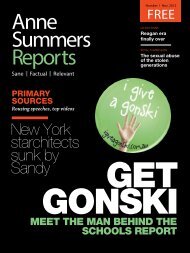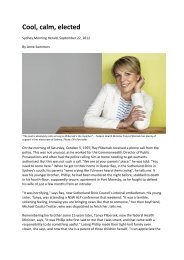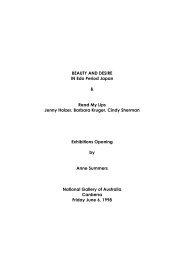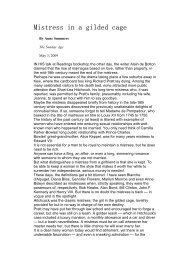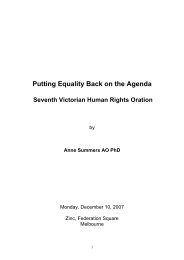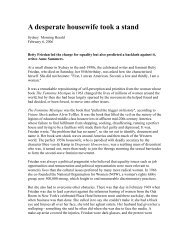Read speech here
Read speech here
Read speech here
Create successful ePaper yourself
Turn your PDF publications into a flip-book with our unique Google optimized e-Paper software.
The Commonwealth’s role in improving the<br />
safety of women and children<br />
NSW Legal Aid, Women’s Domestic Violence Court Assistance Program<br />
Annual Conference, Sydney, 2 August 2007<br />
Acknowledgements.<br />
E & O E – PROOF ONLY<br />
___________________________________<br />
Thank you for this opportunity to talk to you about violence against women and<br />
children – an issue which touches - and damages - the lives of too many Australians.<br />
Violence in our community is a significant problem. Both men and women are<br />
victims of violence, but t<strong>here</strong> is a difference in w<strong>here</strong> and how violence usually<br />
occurs. Of assaults men experience, seventy per cent are attacks by male strangers,<br />
w<strong>here</strong>as the same percentage of women will be attacked instead by their male<br />
partner, friend or relative 1 .<br />
We should be making an effort throughout the community to reduce violent crime,<br />
but a criminal justice approach is not enough when we’re dealing with domestic<br />
violence and sexual assault. The unique relationships between victims and<br />
perpetrators of domestic violence demand an approach specific to the problem.<br />
I have been asked to talk to you today about ‘what the Commonwealth could do to<br />
improve the safety of women and children who experience domestic violence’.<br />
As you all know, the states and territories have primary carriage for most direct<br />
services in this area.<br />
According to the current Federal Office for Women, the Commonwealth’s role in<br />
working towards the elimination of violence against women is in ‘informing policy,<br />
programs and practice’ 2 .<br />
I think we can go a bit beyond that. In my view, the Federal Government has four<br />
key roles to play in this area:<br />
1 Personal Safety Survey (ABS), 2006<br />
2 Office for Women website, Department of Family and Community Services (FaCSIA), August 2007.
1. education and prevention to reduce violence, and so that each generation will<br />
be less likely to commit or be victims of violence as adults;<br />
2. to provide leadership and encourage cooperation across;<br />
3. to provide financial assistance through social security support and other<br />
relevant joint state and territory agreements; and<br />
4. to ensure that federal laws prioritise the safety of victims of violence and the<br />
best interests of children.<br />
1. Prevention<br />
It is disturbing that one quarter of our young people have witnessed violence against<br />
their mother or stepmother 3 .<br />
According to a report conducted by the Victorian Department of Human Services,<br />
around 97 per cent of those surveyed said they “did not believe violence could be<br />
justified”, but nearly “one in four respondents believed that domestic violence can be<br />
excused if the perpetrator genuinely regrets what they have done afterward or if the<br />
violence results from a temporary loss of control” 4 .<br />
Children must be educated to understand that violent behaviour is not excusable and<br />
to aspire to have respectful relationships. Individuals need to take responsibility for<br />
their actions, but government also needs to lead. Successful prevention campaigns<br />
have meant that Australia now has the lowest smoking rates in the world.<br />
The current Government’s primary response to violence against women is the,<br />
Violence Against Women Australia Says No campaign. You would all remember the<br />
controversy surrounding the campaign’s launch: the Government jettisoned a<br />
carefully researched and planned campaign that focussed on perpetrators taking<br />
responsibility for their actions because it seemed to blame men too much for<br />
domestic violence. What’s left is an ad that tells women who have been abused to<br />
call a phone number.<br />
T<strong>here</strong>’s a big difference between education for the reduction and prevention of<br />
violence and what became the No Respect, No Relationship campaign. A<br />
Commonwealth government does have a role in education and prevention, but it has<br />
to be a task sincerely undertaken and competently executed.<br />
2. Encouraging cooperation and collaboration<br />
According to Australian Bureau of Statistics only one in three women who<br />
experienced physical assault and one in five who experienced sexual assault reported<br />
it to the police in 2005 5 . We need tough laws and good hospital, police and court<br />
procedures across Australia so that all victims of violence are confident that their<br />
claims will be taken seriously.<br />
3 Family Homicide in Australia, Mouzos and Rushforth (Australian Institute of Criminology), 2003<br />
4 Two Steps Forward, One Step Back: Community attitudes to violence against women (Victorian<br />
Department of Health), 2006<br />
5 Personal Safety Survey (ABS), 2006
I was lucky to be in Tasmania on Tuesday and was interested to hear about how the<br />
Tasmanian Government’s relatively new, Safe at Home 6 strategy has been going. I am<br />
aware that Liz Little from Tasmania spoke to you yesterday about this.<br />
I understand that the safe at home philosophy is influencing many other new and<br />
exciting projects across the country.<br />
Pilots in Eastern Sydney and Bega have also shown that in cases w<strong>here</strong> it is assessed<br />
to be safe, it is preferable to instead remove the perpetrator.<br />
In my view, this quiet revolution presents a perfect opportunity for the federal<br />
government to lead the conversation between the jurisdictions in what is better<br />
practise in this area, and to support the dissemination of models that work.<br />
Some of those models were initiated under Partnerships Against Domestic Violence<br />
funding which saw great some research and programmes. Unfortunately funding for<br />
most was wound up in 2005.<br />
3. Funding of social security and joint State and Territory agreements<br />
Another key role the government plays in addressing violence against women and<br />
children is through financial support. This is most relevant in relation to the<br />
provision of adequate contributions to social security assistance and relevant joint<br />
State and Territory agreements such as the Supported Accommodation Assistance<br />
Program (SAAP) and the Commonwealth State Housing Agreement. I am not going<br />
to go into details today about social security, other than to congratulate those of you<br />
who fought for and won changes to the Crisis Payment. I do want to talk briefly<br />
about SAAP.<br />
At the same time the Howard Government has funded the multi-million dollar<br />
advertising campaign Australia Says No, they have actually reduced their contribution<br />
to SAAP by $50 million in real terms, because their contribution does not even keep<br />
pace with increases in the cost of living. If the Government expects the campaign to<br />
be successful, they should allow for an increase on demands on emergency services.<br />
SAAP services are already at breaking point. The most recent figures from the<br />
Australian Institute of Health and Welfare show that half of all women and twothirds<br />
of all their children escaping violence are turned away from refuges each night.<br />
Domestic and family violence is the primary reason people seek emergency<br />
accommodation 7 .<br />
Women will often return to violent homes rather than make their children<br />
homeless, or they will live in fear in caravan parks or other inappropriate<br />
accommodation with inadequate support.<br />
6 Tasmania’s Safe At Home: A whole of government response to domestic violence (Australian Domestic<br />
and Family Violence Clearinghouse), 2006<br />
7 Homeless people in SAAP 2004-05, SAAP national data collection annual report 2004-05 (Australian<br />
Institute of Health and Welfare), 2006.
A Rudd Labor government would work with state and territory governments to<br />
improve access to crisis accommodation, and to secure, long term affordable<br />
housing.<br />
T<strong>here</strong>’s no point talking about safety unless we’re prepared to make sure t<strong>here</strong> are<br />
safe places for victims of domestic violence to go if they leave home; and not just<br />
emergency accommodation, but long term accommodation. We’re also critically<br />
short on dedicated funding for children’s services.<br />
4. Family Law and Child Support<br />
The fourth area of responsibility the Commonwealth has in working towards the<br />
prevention and support of victims of domestic violence is through Commonwealth<br />
law; in particular the Family Law Act and the Child Support Acts.<br />
Of course you are all aware of the changes to both these areas over recent years.<br />
I was interested in some of the findings of the recently released report by the<br />
Australian Institute of Family Studies, 'Allegations of family violence and child abuse in<br />
family law children's proceedings: A pre-reform exploratory study'. The study was<br />
commissioned by the Attorney General’s Department to assist with the Howard<br />
Government’s recently introduced Family Law Violence Strategy.<br />
A significant finding of the study was that more than half the cases in the Family<br />
Court involved allegations of family violence and/or child abuse 8 , with most cases<br />
severe in their nature, involving physical injury or abuse.<br />
Violence typology is explored at length in the first chapter of the AIFS report. The<br />
authors cite research from Johnson and Ferraro (2000) who differentiate incidents of<br />
domestic violence into three categories:<br />
1. intimate terrorism;<br />
2. violent resistance; and<br />
3. situational couple violence.<br />
The categories are relatively self-explanatory, however, it is interesting to note that<br />
unlike intimate terrorism and violent resistance, Johnson argues that situational<br />
couple violence is generally less frequent and is more likely to be equally<br />
reciprocated rather than based on “a range of such control mechanisms that are<br />
employed overwhelmingly by men” 9 .<br />
While it is clearly true that some partner violence is reciprocated, I would be very<br />
concerned if the Commonwealth Government decided to go down the path of<br />
asking the Family Court, for example, to differentiate between categories of violence,<br />
discounting some as less serious.<br />
8 Page VII Key Findings, Allegations of family violence and child abuse in family law children's proceedings: A<br />
pre-reform exploratory study, Australian Institute of Family Studies, 2007.<br />
9 Page 6, Allegations of family violence and child abuse in family law children's proceedings: A pre-reform<br />
exploratory study, Australian Institute of Family Studies, 2007.
I am sure we’ll all be watching developments in this area closely. Any future changes<br />
to the family law system must ensure the protection of children and parents from<br />
violence and abuse. As Labor flagged at the time of the debate over the family law<br />
changes, children’s safety and wellbeing must be the priority.<br />
I noticed recently that the Child Support Agency is just about to start their media<br />
campaign regarding the recent scheme changes. I understand that they will be<br />
spending around $36 million over the next five years on the campaign. I thought that<br />
it was interesting that, “T<strong>here</strong> is $1.8 million (funding allocated in the campaign) over<br />
three years….to fund advocacy groups to provide communication to their<br />
constituents” 10 .<br />
The Child Support System is perhaps one of the most controversial areas of<br />
government. Most members of parliament will tell you that a fair proportion of their<br />
case work are CSA cases. And yet the principle of non-residential parents<br />
contributing to the cost of caring for their children is absolutely right.<br />
Some advocacy groups in this area are quite passionate and a little one-eyed. It is<br />
irregular at the best of times for governments to give funding to advocacy groups to<br />
promote government legislation to their members. It will be interesting to see who<br />
gets this money and what tendering process is used. I would like to hope that<br />
residential and non-residential parent representative groups will be equally<br />
represented in funding allocations.<br />
Rudd Labor vision<br />
A Rudd Labor Government will offer a strong and sustained commitment to end<br />
violence against women and children.<br />
Instead of the piecemeal approach of the recent years, in which programs are funded<br />
then abandoned, advertising campaigns started then scrapped and community groups<br />
all around the country struggle on their own, re-inventing the wheel, a Rudd Labor<br />
Government will develop a National Plan to Prevent Violence Against Women and<br />
Children. This National Plan will set out a co<strong>here</strong>nt national vision for the prevention<br />
of violence against women and children. It will include domestic and family violence,<br />
sexual assault, child sexual assault and other forms of violence against children. The<br />
National Plan to Prevent Violence Against Women and Children will be long term. It will<br />
be accountable. It will allocate responsibility and set out timelines for change.<br />
This plan will be overseen by a National Council to make sure it is effective and<br />
accountable. Key members of the Council will include: law enforcement agencies;<br />
academics; expert organisations such as the Women’s Services Network and the<br />
National Association of Services Against Sexual Violence and survivors of domestic<br />
violence and sexual assault. This Council will work across government from a public<br />
health framework to prevent violence before it happens.<br />
10 F&PA 81, Senate Finance and Public Administration Committee, 2007-08 Budget Estimates, 24<br />
May 2007
A public health approach is evidence-based; it focuses on the health of communities<br />
as a whole, especially on those at greatest risk of disease or injury allowing us to<br />
take account, for example, of Aboriginal women and children’s greater statistical<br />
likelihood of experiencing family violence and tailoring our responses accordingly.<br />
The public health approach does not replace criminal justice and human rights<br />
responses to violence; rather, it complements them by placing an additional strong<br />
emphasis on prevention. As with drink driving, we try and prevent it, but when<br />
people are caught doing it, we throw the book at them.<br />
A National Plan to Prevent Violence Against Women and Children will mean that<br />
innovative, evidence-based projects are promoted and hopefully shared between the<br />
States.<br />
Federal Governments have always been responsible for the security of the nation:<br />
our Prime Ministers have led us into war; have sought to defend us from invasion in<br />
the Second World War; now seek to defend us from terrorism. We spend $22<br />
billion dollars a year 11 on defence.<br />
The sad truth is, for many women and children, the most dangerous place in the<br />
world for them is their own home. They’re a million more likely to die at the hands<br />
of their partner than to be blown up by a terrorist. If we put one tenth of the effort<br />
we put into national security into security at home, we could beat this.<br />
Ends.<br />
For more information please go to www.alp.org.au or phone Tanya Plibersek’s office on<br />
(02) 9357 6366. To be added to Tanya Plibersek’s women’s update list, please email<br />
Monika.Wheeler@aph.gov.au.<br />
11 2007-2008 Budget summary pamphlet, Department of Defence



